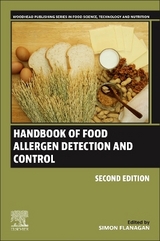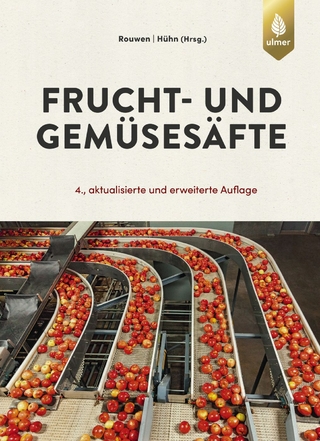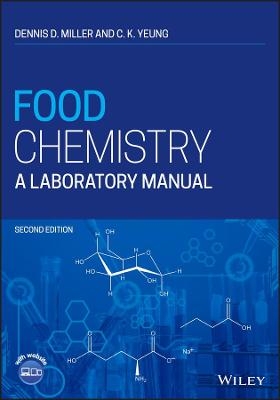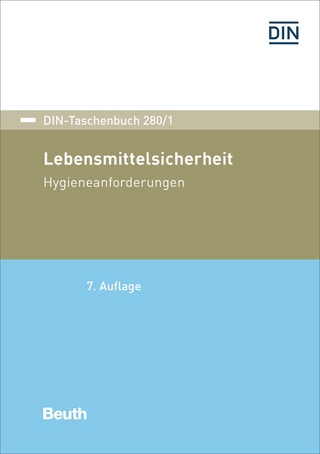
Handbook of Food Allergen Detection and Control
Woodhead Publishing Ltd (Verlag)
978-1-78242-012-5 (ISBN)
- Titel erscheint in neuer Auflage
- Artikel merken
Simon Flanagan is an internationally acclaimed specialist in the field of food allergens. He is a biochemist by training and gained experience of working in a variety of sectors within the food industry before joining Reading Scientific Services Ltd (RSSL) in 2002. In his RSSL role Simon has worked with global blue-chip manufacturers, retailers and ingredient suppliers, as well as manufacturers of specialist dietary products to provide guidance on risk assessment, risk mitigation and management and analytical techniques for allergen detection in foods. Simon’s remit involved a broad scope of projects, from futureproofing corporate allergen policy through to independent expert site risk assessment and training programs and incident management. Since 2005 Simon has been a key advisor to the Cadbury and more latterly Kraft / Mondelēz International on allergen control and responsible for developing policy, strategy and training. In 2016 Simon became an extended member of the Food Safety Team and is currently the Global Lead for Food Allergens and Food Allergy advising the business on both proactive allergen strategy and reactive lead for allergen incidents. Simon is affiliated with numerous professional bodies, industry groups and technical committees (ILSI Europe, FDF, BRC, EFSA, FSA, FARRP, FAO/WHO) and has published numerous articles in peer reviewed journals. He was also principal editor for the ‘Handbook of Food Allergen Detection and Control’. He was presented with a technical leadership award in 2014 for contributions to food safety and a SOFHT industry award for the development of RSSL’s practical allergen workshops. He was also awarded ‘Food and Drink Scientist of the Year’ at the FDF awards in 2018. Simon was one of the first to develop a practical methodology for quantitative allergen risk assessment (QRA), which is becoming widely accepted as industry best practice; QRA was recently recommended by The WHO/FAO Ad-Hoc expert group on Food Allergen Risk Assessment for the application of Precautionary Allergen Labelling.
List of contributors
Woodhead Publishing Series in Food Science, Technology and Nutrition
1: Introduction to food allergy
Abstract
1.1 Introduction: what is food allergy?
1.2 Other food intolerances
1.3 Food allergy prevalence and patterns
1.4 What is a food allergen?
1.5 Food allergen risk management
1.6 The value of having food allergen data
1.7 Challenges and considerations in food allergen analysis
1.8 Conclusions
Part One: Managing allergens in the food chain
2: Traceability of allergenic foods in the food chain
Abstract
2.1 Introduction
2.2 Legislation, standards and guidance
2.3 Traceability systems
2.4 Analytical methods used in traceability investigations
2.5 Conclusions
3: Food allergen risk assessment and management
Abstract
3.1 Introduction
3.2 Food allergy as a public health issue
3.3 Risk assessment for food allergens: background and issues
3.4 Development of risk assessment for food allergens
3.5 Practical aspects of risk assessment
3.6 Risk management
3.7 Conclusions
4: Assessment and communication of allergen risks in the food chain
Abstract
4.1 Introduction
4.2 Principles and methods
4.3 Allergen risk assessment and hazard characterisation
4.4 Risk communication
4.5 Risk assessment to allergen control plan
4.6 Current research and future trends
4.7 Conclusions
5: Hygienic design and cleaning as an allergen control measure
Abstract
5.1 Introduction
5.2 Hygienic design: regulations and norms
5.3 Hygienic equipment design
5.4 Hygienic building design
5.5 Integrating hygienic systems/hygienic engineering
5.6 Cleaning as an allergen control measure
5.7 Allergen cleaning: verification and validation
6: Effective allergen management practices to reduce allergens in food
Abstract
6.1 Introduction
6.2 The retailer’s perspective
6.3 The allergy journey
6.4 Labelling and packaging
6.5 Marks & Spencer packaging evolution
6.6 Allergen management risk assessment
6.7 Marks & Spencer’s risk assessment process
6.8 Factory standards and controls
6.9 Gluten-free
6.10 Next steps
Acknowledgements
7: Consumer attitudes to allergens in foods
Abstract
7.1 Introduction
7.2 Which consumers are avoiding foods and why?
7.3 What information do these consumers need?
7.4 Living with food allergy
7.5 Information from packaging
7.6 Challenges for consumers at different stages of life
7.7 Summary of consumer needs
7.8 How can food suppliers ensure consumer confidence and trust?
7.9 Conclusions and future trends
7.10 Sources of further information and advice
Acknowledgements
8: Assessing and managing allergenicity of genetically modified (GM) foods
Abstract
8.1 Introduction
8.2 Assessing the allergenicity of novel proteins
8.3 Key steps in allergenicity assessment
8.4 Environmental factors affecting allergenicity
8.5 Assessing the allergenicity of whole GM plants
8.6 Assessing the allergenicity of products from GM animals
8.7 Post-market monitoring
8.8 Conclusion
Part Two: Detecting allergens in food
9: Sampling for food allergens
Abstract
9.1 Introduction
9.2 Reasons to sample for food allergens and sampling plans
9.3 Approaches to sampling
9.4 Sample types
9.5 Quality of the sample
9.6 Future trends
10: Enzyme-linked immunosorbent assays (ELISAs) for detecting allergens in food
Abstract
10.1 Introduction
10.2 Principles of an enzyme immunoassay
10.3 Main components of ELISA
10.4 Detection issues relating to particular allergens: egg, milk, nuts, prolamins and glutelins
10.5 Validation, characteristical parameters of ELISA and collaborative studies
10.6 Conclusions
11: Lateral flow devices for detecting allergens in food
Abstract
11.1 Introduction
11.2 Lateral flow devices
11.3 Development of a lateral flow device
11.4 Key issues in using lateral flow devices
11.5 Future trends
11.6 Conclusions
11.7 Sources of further information and advice
12: Surface plasmon resonance (SPR) sensors for detecting allergens in food
Abstract
12.1 Introduction
12.2 Development of an SPR food allergen biosensor
12.3 Applications of SPR for food allergen detection: peanuts
12.4 Detection of shellfish toxins with SPR
12.5 High-throughput food allergen profiling with imaging SPR
12.6 Future trends
12.7 Conclusions
13: Polymerase chain reaction (PCR) methods for detecting allergens in foods
Abstract
13.1 Introduction
13.2 Advantages of PCR for allergen detection
13.3 PCR principles and methods
13.4 Multi-allergen detection and quantification with PCR
13.5 PCR performance characteristics
13.6 Conclusions and future trends
14: Optical thin film biochips for detecting allergens in food
Abstract
14.1 Introduction
14.2 Principles of optical thin film biochips
14.3 Applications for detection of allergenic foods
14.4 Advantages and disadvantages of optical thin film biosensor chip assays
14.5 Future trends
14.6 Conclusions
15: IgE antibody-based analysis for detecting allergens in food
Abstract
15.1 Introduction
15.2 General considerations
15.3 IgE antibody-based in vivo assay for food allergen potency assessment
15.4 IgE antibody-based in vitro assays for food allergen potency assessment
15.5 Applications in the detection of peanuts
15.6 Allergosorbent competitive inhibition assay: strengths and weaknesses
15.7 Future trends
Appendix: abbreviations
16: Validation, standardisation and harmonisation of analytical methods and test kits for detecting allergens in food
Abstract
16.1 Introduction
16.2 Different methods for the detection of allergens in food
16.3 Comparing the different methods
16.4 Limitations of the different methods and how they can be overcome
16.5 Importance of validation and good practices
16.6 Challenges of standardisation and harmonisation of analytical methods
16.7 Future trends
Part Three: Case studies: detection and control of specific food allergens
17: Detection and control of eggs as a food allergen
Abstract
17.1 Introduction
17.2 Egg allergy
17.3 Egg allergens
17.4 Detection of egg allergens
17.5 Enzyme-linked immunosorbent assay (ELISA)
17.6 Other techniques: western blots, lateral flow and polymerase chain reaction (PCR) devices
17.7 Future trends
17.8 Conclusion
18: Detection and control of soybeans as a food allergen
Abstract
18.1 Introduction
18.2 Soybeans and their food uses
18.3 Soybean allergy: prevalence and potency
18.4 Clinical manifestations and severity of soybean allergy
18.5 Soybean allergens
18.6 Detection of soy residues
18.7 Control of soy residues in food manufacturing facilities
18.8 Future trends
18.9 Conclusions
18.10 Sources of further information and advice
19: Detection and control of gluten as a food allergen
Abstract
19.1 Introduction
19.2 Pathogenesis of celiac disease (CD)
19.3 Testing of gluten toxicity
19.4 Current EU labeling and codex guidelines
19.5 Methods for measurement of gluten contamination in foods
19.6 Future trends and summary
20: Detection and control of fish, shellfish and molluscs as food allergens
Abstract
20.1 Introduction
20.2 Classification of seafood and seafood protein characteristics
20.3 Seafood as allergens
20.4 Epidemiology of seafood allergy
20.5 Manifestations of seafood allergies
20.6 Management of seafood allergies
20.7 Summary and future trends
21: Detection and control of mustard and sesame as food allergens
Abstract
21.1 Introduction
21.2 Mustard as an allergen
21.3 The major allergic proteins in mustard
21.4 Detection of mustard allergens and markers in food
21.5 Sesame as an allergen
21.6 The major allergic proteins in sesame
21.7 Detection of sesame allergens and markers in food
21.8 Future trends
Index
| Reihe/Serie | Woodhead Publishing Series in Food Science, Technology and Nutrition |
|---|---|
| Verlagsort | Cambridge |
| Sprache | englisch |
| Maße | 152 x 229 mm |
| Gewicht | 770 g |
| Themenwelt | Technik ► Lebensmitteltechnologie |
| ISBN-10 | 1-78242-012-6 / 1782420126 |
| ISBN-13 | 978-1-78242-012-5 / 9781782420125 |
| Zustand | Neuware |
| Informationen gemäß Produktsicherheitsverordnung (GPSR) | |
| Haben Sie eine Frage zum Produkt? |
aus dem Bereich



